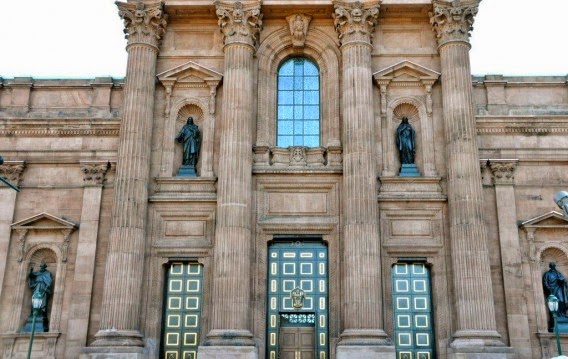Why to go: The diocese has designed a pilgrimage “passport” to record your journey. Download a copy at http://www.rockforddiocese.org/jubileeofmercy/files/Pilgrimage-Passport.pdf to record your visits.
Two of the pilgrimage parishes represent the Rockford Deanery. They are the Cathedral of St. Peter and the chapel of the Poor Clare Monastery.
 |
| Cathedral of St. Peter |
In the early days of Bishop Peter J. Muldoon’s episcopacy, Rockford was in one of its periods of expansion. There was much building going on, particularly in the north end. Many of the Catholics living north of Auburn Street had a long distance to travel to St. Mary Church. On June 4, 1915, property was bought in the Auburndale subdivision and a small frame chapel was built on it later that year. The cornerstone for the current church was blessed by Bishop Loras T. Lane in August of 1958 and the church was dedicated on May 15, 1960. On Oct. 11, 1970, Bishop Arthur J. O’Neill designated St. Peter as the cathedral for the diocese.
Info: Address: Cathedral of St. Peter, 1423 N. Court St., Rockford. Phone: 815/965-2765 Website: www.cathedralofstpeter.org
 |
| Poor Clares Corpus Christi Chapel |
Poor Clares Chapel: Father David Vogel will open the holy door at 7 a.m. Dec. 13.
Bishop Peter J. Muldoon wanted a community of contemplative sisters within the diocese. Repeatedly he requested Mother Mary Theresa, of the Poor Clares in Cleveland, to open a foundation in Rockford. Finally in March, 1916, two Poor Clare sisters arrived in Rockford to establish a community here. A residence on North Avon Street was converted into a monastery and was used until 1920, when growth of the community necessitated the purchase of the present property on South Main St.
Info: Address: Poor Clare Monastery, 2111 S. Main St., Rockford Phone: 815/963-7343 Website: http://www.cloisteredlife.com/poor-clares/
(Grand) Kid friendly: All the churches in the pilgrimage welcome children.
Watch for more Year of Mercy pilgrimage stops in future blogs.
Learn more about the pilgrimages and other jubilee events at The Observer’s The Year of Mercy blog at http://observer.rockforddiocese.org/year-of-mercy
— Compiled by Sharon Boehlefeld
Send Destination ideas to SeasonedObserver@rockforddiocese.org


















